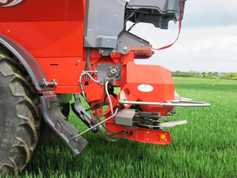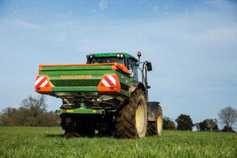Slurry spreading: Remember watery slurry is more efficient and easier to manage if spreading at this time of the year. The nutrients will get to work quicker and the spoiling effect on paddocks will be smaller as young grass leaves begin to emerge. This might mean that if you can, add water to slurry to dilute the slurry before spreading.
Early nitrogen: The questions have started on spreading nitrogen. Soil temperatures are key for growth and spreading of nitrogen. Keep track with your own gauge or follow Met Éireann data. Some near the coast and down south, etc, haven’t had as much frost. For growth, you need soil temperatures in excess of 6°C. Some will say you will get growth at 5°C with some new varieties.
What type of nitrogen to spread? The first thing is that urea is still better value/kg of nitrogen than other nitrogen sources. Depending on what price you can buy it at, urea is cheaper per unit of nitrogen by 20-30% compared with CAN, etc. Don’t spread nitrogen on paddocks with low soil phosphorus levels. How much to spread? Over the last few years, farmers have switched from spreading a bag of nitrogen to blanket-spreading a half-bag now and coming back with a half-bag six weeks later. This is dependent on the overall stocking rate, calving date and how compact your calving is. Heavily stocked farms further south, that have compact calving and good soil temperatures, will blanket-spread closer to a bag now and get a good response.What paddocks to spread on? Don’t spread early nitrogen on paddocks that have not been reseeded in the last 10 years. Don’t spread on wet or heavy paddocks that are not going to be grazed early. Some will skip spreading the first paddock for grazing, but make sure you spread it afterwards – don’t leave it until April. If spreading a half-bag over the next few weeks, the key is to make sure you come back in with a half-bag again within five to six weeks. Otherwise you lose out. December milk: If you milked cows on grazed grass into mid-December, then you need to fluke and worm these cows soon. On some farms, these late-milking cows are only indoors four weeks at this stage. There is no point in using a fluke product that will only kill adult fluke. You need a product that will kill all the stages. Be mindful of when the cow is calving as milk withdrawal issues can occur with all fluke products.
Feeding in calf heifers: A lot of farmers feed 1kg-2kg of meal to in-calf heifers with ad-lib good-quality silage. On some farms there is no need for meal as heifers are very well grown. Sometimes feeding too much can make heifers flag up with milk and this can cause cell count problems if heifers start running milk before calving. Keep beds clean and limed. Some farmers will teat-spray these heifers daily, in an attempt to protect them from infection. The last two weeks before heifers calve are critical for infection in milk. There are some products available to spray onto teats to create a seal, but no independent research is available to check if they work.
Slurry spreading: Remember watery slurry is more efficient and easier to manage if spreading at this time of the year. The nutrients will get to work quicker and the spoiling effect on paddocks will be smaller as young grass leaves begin to emerge. This might mean that if you can, add water to slurry to dilute the slurry before spreading.
Early nitrogen: The questions have started on spreading nitrogen. Soil temperatures are key for growth and spreading of nitrogen. Keep track with your own gauge or follow Met Éireann data. Some near the coast and down south, etc, haven’t had as much frost. For growth, you need soil temperatures in excess of 6°C. Some will say you will get growth at 5°C with some new varieties.
What type of nitrogen to spread? The first thing is that urea is still better value/kg of nitrogen than other nitrogen sources. Depending on what price you can buy it at, urea is cheaper per unit of nitrogen by 20-30% compared with CAN, etc. Don’t spread nitrogen on paddocks with low soil phosphorus levels. How much to spread? Over the last few years, farmers have switched from spreading a bag of nitrogen to blanket-spreading a half-bag now and coming back with a half-bag six weeks later. This is dependent on the overall stocking rate, calving date and how compact your calving is. Heavily stocked farms further south, that have compact calving and good soil temperatures, will blanket-spread closer to a bag now and get a good response.What paddocks to spread on? Don’t spread early nitrogen on paddocks that have not been reseeded in the last 10 years. Don’t spread on wet or heavy paddocks that are not going to be grazed early. Some will skip spreading the first paddock for grazing, but make sure you spread it afterwards – don’t leave it until April. If spreading a half-bag over the next few weeks, the key is to make sure you come back in with a half-bag again within five to six weeks. Otherwise you lose out. December milk: If you milked cows on grazed grass into mid-December, then you need to fluke and worm these cows soon. On some farms, these late-milking cows are only indoors four weeks at this stage. There is no point in using a fluke product that will only kill adult fluke. You need a product that will kill all the stages. Be mindful of when the cow is calving as milk withdrawal issues can occur with all fluke products.
Feeding in calf heifers: A lot of farmers feed 1kg-2kg of meal to in-calf heifers with ad-lib good-quality silage. On some farms there is no need for meal as heifers are very well grown. Sometimes feeding too much can make heifers flag up with milk and this can cause cell count problems if heifers start running milk before calving. Keep beds clean and limed. Some farmers will teat-spray these heifers daily, in an attempt to protect them from infection. The last two weeks before heifers calve are critical for infection in milk. There are some products available to spray onto teats to create a seal, but no independent research is available to check if they work.






 This is a subscriber-only article
This is a subscriber-only article










SHARING OPTIONS: